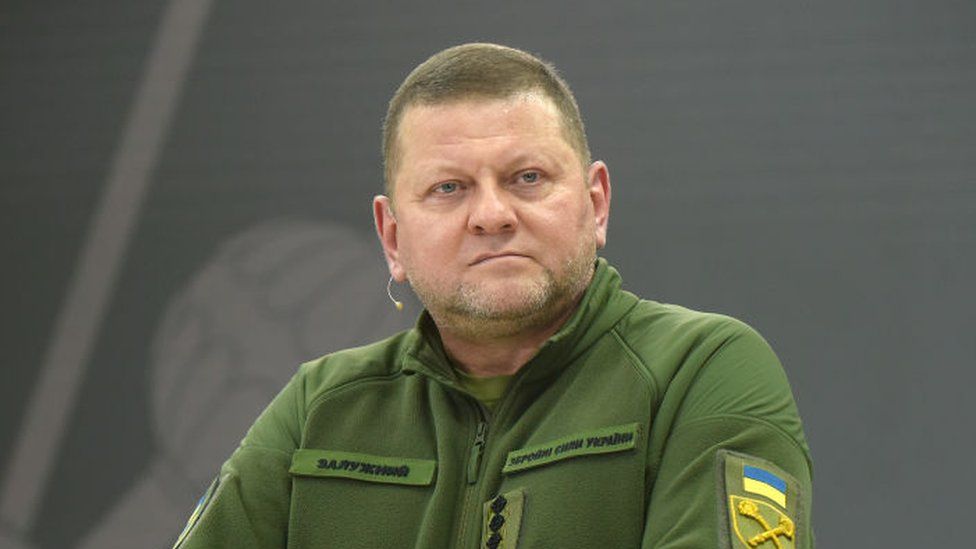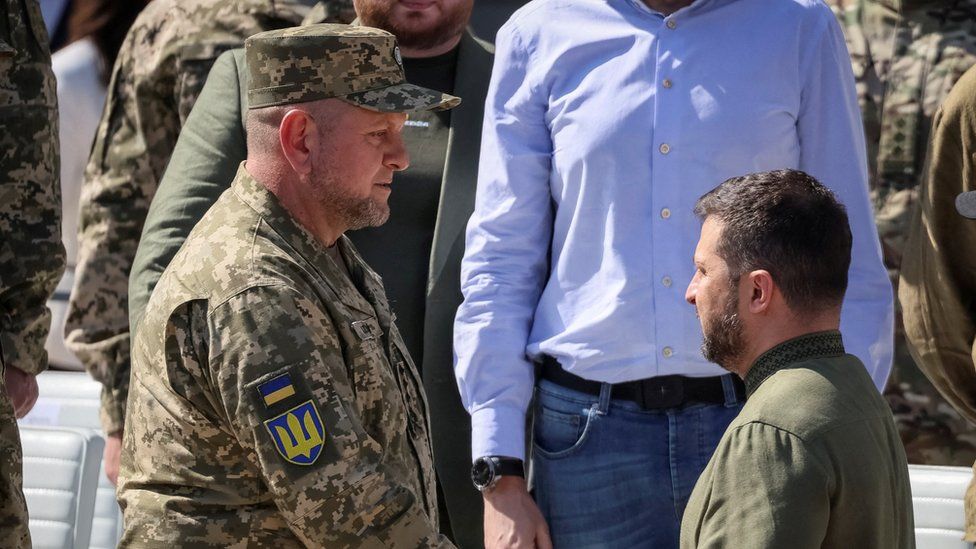
By Jonathan Beale
Defence Correspondent
That in itself has been damaging. Strain at the top does not bolster morale at home or abroad.
Confirmation of General Zaluzhnyi’s removal will not immediately resolve the crises either. Ukraine is struggling on the battlefield, facing shortages of both ammunition and manpower.
Removing Zaluzhnyi as commander in chief, but keeping him as part of the team, may be politically astute for President Zelensky. Some opinion polls suggest the general was more popular than the president.
We know only a little about why Mr Zelensky decided to make a change.
Remember that Gen Zaluzhnyi was hand-picked for the job by him in 2021 – ahead of more senior officers. He had already proven himself in battle as a commander in eastern Ukraine, fighting pro-Russian separatists from 2014.
But the reality is that it is the president’s prerogative to appoint who he wants as leader of the nation’s military.
Gen Ben Hodges, the former head of the US Army in Europe, says: “When it becomes apparent that the government has lost confidence in you, it is your duty to step down because of the principle of civilian control over the military.”
“My impression was this was a guy who was trying to change and modernise [Ukraine’s military], to get rid of all the old Soviet era thinking,” Gen Hodges, who had several dealings with Gen Zaluzhnyi, says.
He also thinks history will judge him kindly: “He’ll correctly get a lot of credit for having stopped the Russians.”
Gen Zaluzhnyi was facing a huge challenge to transform Ukraine’s military into a modern Nato military machine.
The defence analyst and expert Justin Crump says it was a near impossible task. Not least, he says, because Ukrainian soldiers were often only given a few weeks of Western training.
Gen Zaluzhnyi may have been a post-Soviet era general, but he was still heavily influenced by it.
In one of his rare interviews with Western media, he told Time magazine: “I was raised on Russian military doctrine, and I still think that the science of war is all located in Russia.” But he quickly looked to Nato and the West to train, rebuild and restructure his armed forces.
He was soon given credit for turning away from the top-heavy, hierarchical, old Soviet military structures to more nimble Western-style command.
That certainly proved effective in the early days of Russia’s full-scale invasion – with Ukraine adopting quick hit-and-run tactics against long, unwieldy, columns of Russian troops and armour.

At the time, the former head of the US military, Gen Mark Milley, credited President Zelensky with those successes: “His leadership enabled the Ukrainian armed forces to adapt quickly with battlefield initiative against the Russians.”
There was more to come. In the summer of 2022 Gen Zaluzhnyi fooled Russia into thinking Ukraine’s next move would be a massive counter-offensive in the south. Instead he took advantage of weakened Russian defences in the northeast of the country and launched a lightning counter-offensive which took back a huge swathe of territory around north-eastern Kharkiv.
The expected southern offensive still took place and eventually forced Russia to retreat across the Dnipro River – forcing them to quit their occupation of southern Kherson. These early offensives would be the pinnacle of Gen Zaluzhnyi’s battlefield successes. But they also fuelled unrealistic Western expectations of what might happen next.
The subsequent, long-anticipated Ukrainian offensive in the summer of 2023 was supposed to be decisive. It wasn’t.
In fact Gen Zaluzhnyi ended up calling it “a stalemate”.
- The Inquiry: Is the war in Ukraine at a stalemate?
Mr Crump, who is also CEO of risk and security consultancy Sibylline, says that comment may have led to the breakdown of the relationship between the president and his top military commander.
“The Ukrainian leadership didn’t want to see the word stalemate used – not least to make sure that support [from the West] kept flowing,” he notes.
Even those who spoke in terms of great hope for the offensive now concede it was highly likely to fail.
Gen Hodges says the West would never have tried to do the same without air power. The heavily-mined Russian defensive lines proved hard to break through.
Various briefings from Western military sources since haven’t helped either, says Gen Hodges – with the suggestion that Gen Zaluzhnyi had ignored some of their advice.
Removing military commanders in a time of war is hardly unusual. Former British Prime Minister Winston Churchill did it during World War Two.
And US President Harry S Truman famously dismissed the highly popular Gen Douglas MacArthur at the height of the Korean War. President Truman later said: “I didn’t fire him because he was a dumb son of a bitch, although he was. I fired him because he wouldn’t respect the authority of the president.”
Gen Zaluzhnyi’s departure appears to be a lot more amicable than that. He will remain part of the military team advising the president.
The general has forged close relationships with many Western military leaders. He clearly still has a vision to continue the fight by building an arsenal of drones – which he set out in a recent article in the Economist.
Analyst Mr Crump says the change might be good – “leading a nation and a military in a time of war can get pretty stressful”.
But his replacement, Gen Oleksandr Syrskyi, has also been doing the same as the commander in the east for the last two years. His new job won’t be any easier.https://tehopeng.com/